A Fault-Signal-Based Generalizing Remaining Useful Life Prognostics Method for Wheel Hub Bearings
Abstract
:1. Introduction
- A fault signal model is designed with the signal in a complex and mutative environment to describe the fault damage severity in the inaccurate fault signal data with different fatigue damage types.
- A generalizing RUL prognostics method is designed based on the fault signal model, and the simplified solution of the generalizing RUL prognostics method is deduced.
- The experimental results show that this method gained good accuracies of RUL prognostics for all the amplitude, energy, and kurtosis features with fatigue damage types. This method can process inaccurate fault signals with different kinds of noises in the actual working environment. Additionally, the RUL prognostics method can be conducted in the long term, so the RUL prognostics method has a good generalization.
2. Fault Factors and Indicators of Wheel Hub Bearings
2.1. Fault Mechanism of Wheel Hub Bearings
2.2. Fault Indicators of Wheel Hub Bearings
2.2.1. Inherent Vibrational Frequency of Wheel Hub Bearings
2.2.2. Theoretical Fault Characteristic Frequency of Wheel Hub Bearings
2.2.3. Feature Indicators of Wheel Bearing Vibration Signal
3. Methodology
3.1. Fault Signal Model
3.2. RUL Prognostics Method
3.3. Method Solution
4. Validation
4.1. Experimental Devices and Sensors
4.2. Data Obtainment
4.3. Analysis of Experimental Results
5. Conclusions
Author Contributions
Funding
Conflicts of Interest
References
- Bhaumik, S.K.; Sujata, M.; Venkataswamy, M.A. Fatigue failure of aircraft components. Eng. Fail. Anal. 2008, 15, 675–694. [Google Scholar] [CrossRef] [Green Version]
- Rubio, E.; Juan, C. Jáuregui. Experimental characterization of mechanical vibrations and acoustical noise generated by defective automotive wheel hub bearings. Procedia Eng. 2012, 35, 176–181. [Google Scholar] [CrossRef]
- Meng, Q.; Sun, X. Fault diagnosis approach to vehicle hub bearing unit based on danger theory. In Proceedings of the 11th IEEE International Conference on Networking, Miami, FL, USA, 7–9 April 2014. [Google Scholar]
- Ceyhan, A.; Duruş, M.; Akarsu, C.; Aydın, R.; Aray, A.; Hatık, G.; Tutuk, E.; Özkardeşler, B.C. Wheel Hub Fatigue Performance under Non-constant Rotational Loading and Comparison to Eurocycle Test. Procedia Eng. 2015, 101, 77–84. [Google Scholar] [CrossRef] [Green Version]
- Saxena, M.; Bannett, O.O.; Sharma, V. Bearing Fault Evaluation for Structural Health Monitoring, Fault Detection, Failure Prevention and Prognosis. Procedia Eng. 2016, 144, 208–214. [Google Scholar] [CrossRef] [Green Version]
- Plazenet, T.; Boileau, T.; Caironi, C.; Nahid-Mobarakeh, B. A Comprehensive Study on Shaft Voltages and Bearing Currents in Rotating Machines. IEEE Trans. Ind. Appl. 2018, 54, 3749–3759. [Google Scholar] [CrossRef]
- Zhao, L.; Wang, X. A deep feature optimization fusion method for extracting bearing degradation features. IEEE Access 2018, 6, 19640–19653. [Google Scholar] [CrossRef]
- Qian, Y.; Yan, R.; Gao, R.X. A multi-time scale approach to remaining useful life prediction in rolling bearing. Mech. Syst. Signal Process. 2017, 83, 549–567. [Google Scholar] [CrossRef] [Green Version]
- Wang, D.; Tsui K, L.; Miao, Q. Prognostics and health management: A review of vibration based bearing and gear health indicators. IEEE Access 2018, 6, 665–676. [Google Scholar] [CrossRef]
- Zhou, B.; Lu, C.; Li, L.; Chen, Z. Health assessment for rolling bearing based on local characteristic-scale decomposition—Approximate entropy and manifold distance. In Proceedings of the 2016 12th World Congress on Intelligent Control and Automation (WCICA), Guilin, China, 12–17 June 2016; pp. 401–406. [Google Scholar]
- Lan, C.; Bai, N.; Yang, H.; Liu, C.; Li, H.; Spencer, B.F., Jr. Weibull modeling of the fatigue life for steel rebar considering corrosion effects. Int. J. Fatigue 2018, 111, 134–143. [Google Scholar] [CrossRef]
- Gastaldi, C.; Alfredo, F.; Teresa, B. Forced response prediction of turbine blades with flexible dampers: The impact of engineering modelling choices. Appl. Sci. 2018, 8, 34. [Google Scholar] [CrossRef]
- Carlos, M.; José, J. Intentional mistuning effect in the forced response of rotors with aerodynamic damping. J. Sound Vib. 2018, 433, 212–229. [Google Scholar]
- Abera, T.; Youngseop, B.; Jae-Nam, K.; Beom-Soo, K. Parameter Optimization to Avoid Propeller-induced Structural Resonance of Quadrotor type Unmanned Aerial Vehicle. Compos. Struct. 2018, 193, 63–72. [Google Scholar]
- Loutas, T.H.; Roulias, D.; Georgoulas, G. Remaining Useful Life Estimation in Rolling Bearings Utilizing Data-Driven Probabilistic E-Support Vectors Regression. IEEE Trans. Reliab. 2013, 62, 821–832. [Google Scholar] [CrossRef]
- Ren, L.; Lv, W. Remaining useful life estimation of rolling bearings based on sparse representation. In Proceedings of the 2016 7th International Conference on Mechanical and Aerospace Engineering (ICMAE), London, UK, 18–20 July 2016; pp. 209–213. [Google Scholar]
- Zhai, Q.; Ye, Z.S. RUL prediction of deteriorating products using an adaptive Wiener process model. IEEE Trans. Ind. Inform. 2017, 13, 2911–2921. [Google Scholar] [CrossRef]
- Shao, Y.; Fang, J.; Ge, L.; Ou, J.; Ju, H.; Ma, Y. Fatigue life prediction of rear axle using time series model. In Proceedings of the International Conference on Control, Automation and Systems IEEE, Seoul, Korea, 14–17 October 2008; pp. 1090–1093. [Google Scholar]
- Fridman, S.V.; Yeh, K.C.; Fridman, O.V.; Franke, S.J. Linear and nonlinear prediction techniques for short-term forecasting of HF fading signals. Radio Sci. 2016, 32, 989–998. [Google Scholar] [CrossRef]
- Rai, A.; Upadhyay, S.H. The use of MD-CUMSUM and NARX neural network for anticipating the remaining useful life of bearings. Measurement 2017, 111, 397–410. [Google Scholar] [CrossRef]
- Lee, J.A.; Almond, D.P.; Harris, B. The use of neural networks for the prediction of fatigue lives of composite materials. Compo. Part A Appl. Sci. Manuf. 1999, 30, 1159–1169. [Google Scholar] [CrossRef]
- Muetze, A.; Strangas, E.G. The Useful Life of Inverter-Based Drive Bearings: Methods and Research Directions from Localized Maintenace to Prognosis. IEEE Ind. Appl. Mag. 2016, 22, 65–73. [Google Scholar] [CrossRef]
- Nie, Y.; Wan, J. Estimation of remaining useful life of bearings using sparse representation method. In Proceedings of the Prognostics and System Health Management Conference (PHM), Beijing, China, 21–23 October 2015; pp. 1–6. [Google Scholar]
- Kogan, G.; Klein, R.; Bortman, J. A physics-based algorithm for the estimation of bearing spall width using vibrations. Mech. Syst. Signal Process. 2018, 104, 398–414. [Google Scholar] [CrossRef]
- Baek, S.H.; Cho, S.S.; Joo, W.S. Fatigue life prediction based on the rainflow cycle counting method for the end beam of a freight car bogie. Int. J. Automot. Technol. 2016, 9, 95–101. [Google Scholar] [CrossRef]
- Chen, X.D.; Xia, J. Differential Hydrological Grey Model (DHGM) with self-memory function and its application to flood forecasting. Sci. China Ser. E Technol. Sci. 2009, 52, 1039–1049. [Google Scholar] [CrossRef]
- Tsai, L.; Liou, H.Y.; Lin, J.L.; Huang, Y.T. On Fatigue Life Prediction Utilizing Grey Theory. J. Grey Syst. 2016, 4, 321–330. [Google Scholar]
- Wang, D.; Tsui, K.L. Two novel mixed effect models for prognostics of rolling element bearings. Mech. Syst. Signal Process. 2018, 99, 1–13. [Google Scholar] [CrossRef]
- Zhang, B.; Zhang, L.; Xu, J. Degradation Feature Selection for Remaining Useful Life Prediction of Rolling Element Bearings. Qual. Reliab. Eng. Int. 2016, 32, 547–554. [Google Scholar] [CrossRef]
- Wang, D.; Tsui, K.L. Brownian motion with adaptive drift for remaining useful life prediction: Revisited. Mech. Syst. Signal Process. 2018, 99, 691–701. [Google Scholar] [CrossRef]
- Ren, L.; Sun, Y.; Cui, J.; Zhang, L. Bearing remaining useful life prediction based on deep auto encoder and deep neural networks. J. Manuf. Syst. 2018, 48, 71–77. [Google Scholar] [CrossRef]
- Jin, X.; Sun, Y.; Que, Z.; Wang, Y.; Chow, T.W. Anomaly detection and fault prognosis for bearings. IEEE Trans. Instrum. Meas. 2016, 65, 2046–2054. [Google Scholar] [CrossRef]
- Peng, Y.; Cheng, J.; Liu, Y.; Li, X.; Peng, Z. An adaptive data-driven method for accurate prediction of remaining useful life of rolling bearings. Front. Mech. Eng. 2018, 13, 301–310. [Google Scholar] [CrossRef]
- Hu, Y.; Li, H.; Shi, P.; Chai, Z.; Wang, K.; Xie, X.; Chen, Z. A prediction method for the real-time remaining useful life of wind turbine bearings based on the Wiener process. Renew. Energy 2018, 127, 452–460. [Google Scholar] [CrossRef]
- Li, N.; Lei, Y.; Liu, Z.; Lin, J. A particle filtering-based approach for remaining useful life predication of rolling element bearings. In Proceedings of the 2014 IEEE Conference on Prognostics and Health Management (PHM), Zhangjiajie, China, 24–27 August 2014; pp. 1–8. [Google Scholar]
- Deutsch, J.; He, M.; He, D. Remaining useful life prediction of hybrid ceramic bearings using an integrated deep learning and particle filter approach. Appl. Sci. 2017, 7, 649. [Google Scholar] [CrossRef]
- Yoo, Y.; Baek, J.G. A Novel Image Feature for the Remaining Useful Lifetime Prediction of Bearings Based on Continuous Wavelet Transform and Convolutional Neural Network. Appl. Sci. 2018, 8, 1102. [Google Scholar] [CrossRef]
- Lei, Y.; Li, N.; Jia, F.; Lin, J.; Xing, S. A Nonlinear Degradation Model Based Method for Remaining Useful Life Prediction of Rolling Element Bearings. In Proceedings of the 2015 Prognostics and System Health Management Conference, Beijing, China, 21–23 October 2015. [Google Scholar]
- Lei, Y.; Li, N.; Gontarz, S.; Lin, J.; Radkowski, S.; Dybala, J. A Model-Based Method for Remaining Useful Life Prediction of Machinery. IEEE Trans. Reliab. 2016, 65, 1314–1326. [Google Scholar] [CrossRef]
- Wang, B.; Lei, Y.; Li, N.; Li, N. A Hybrid Prognostics Approach for Estimating Remaining Useful Life of Rolling Element Bearings. IEEE Trans. Reliab. 2018, 99, 1–12. [Google Scholar] [CrossRef]
- Wang, B.; Lei, Y.; Li, N.; Li, N. Real-time bearing residual life prediction based on status excursion. In Proceedings of the 2016 Prognostics and System Health Management Conference, Chengdu, China, 19–21 October 2016; pp. 1–4. [Google Scholar]
- Cao, H. Self-memorization Equation in Atmospheric Motion. Sci. China Ser. B. 1993, 36, 845–855. [Google Scholar]

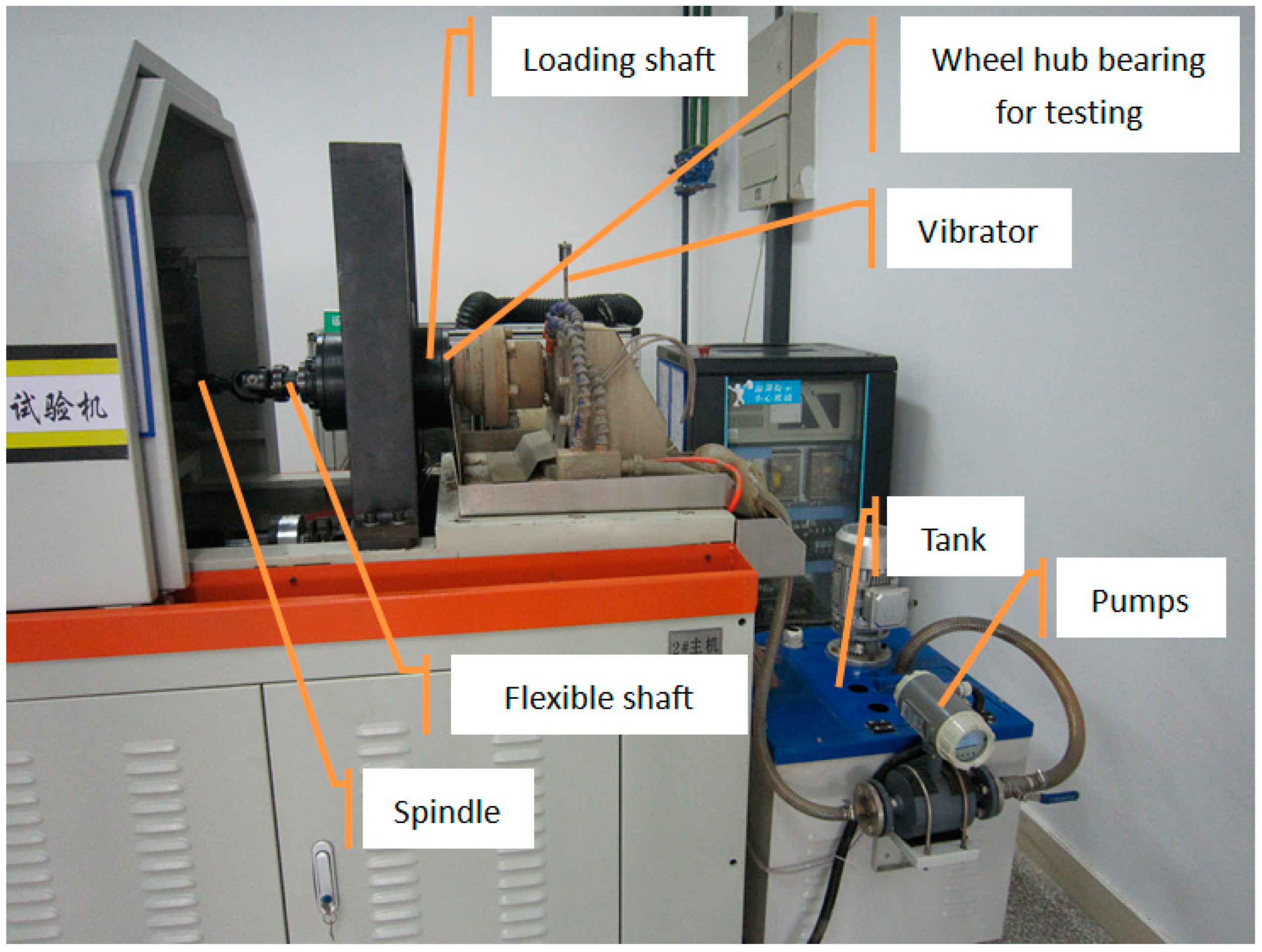
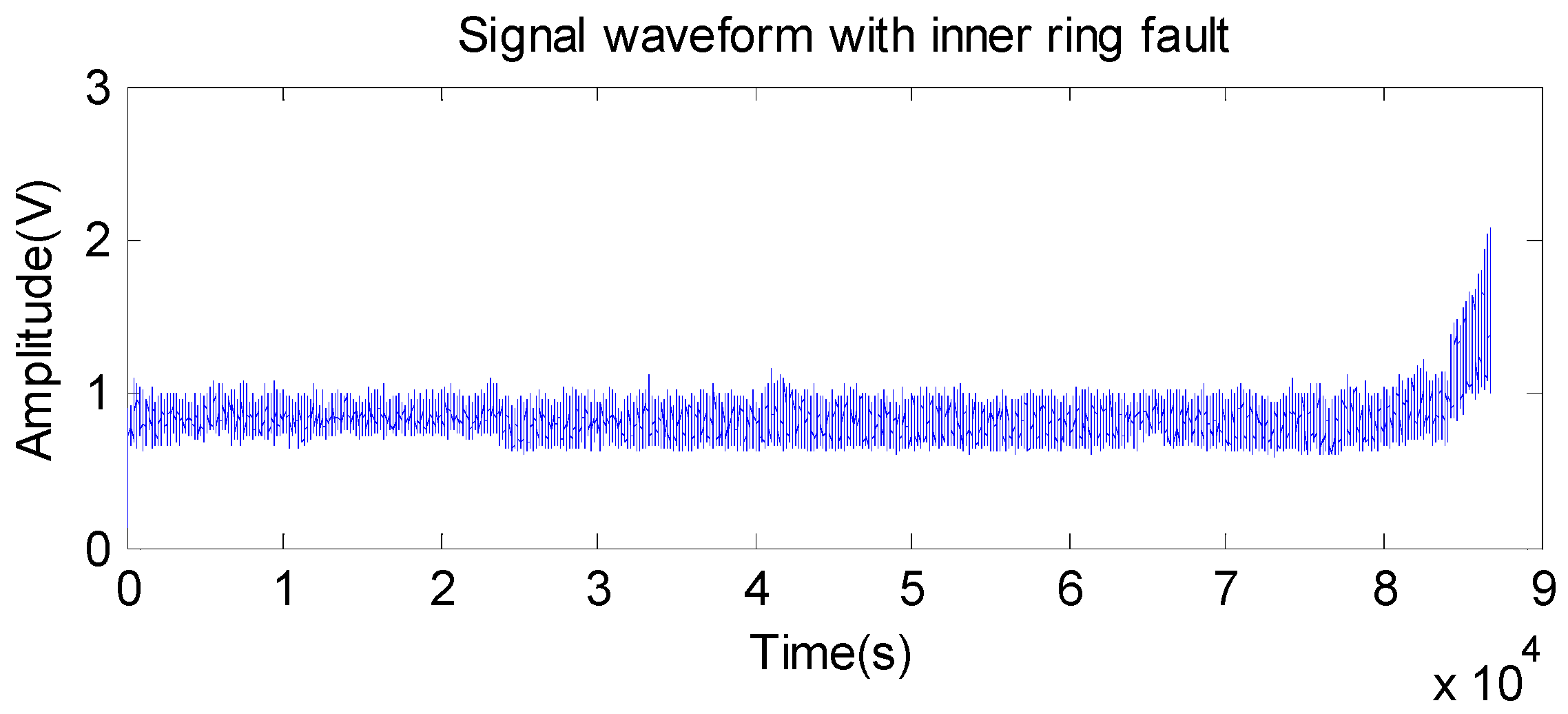
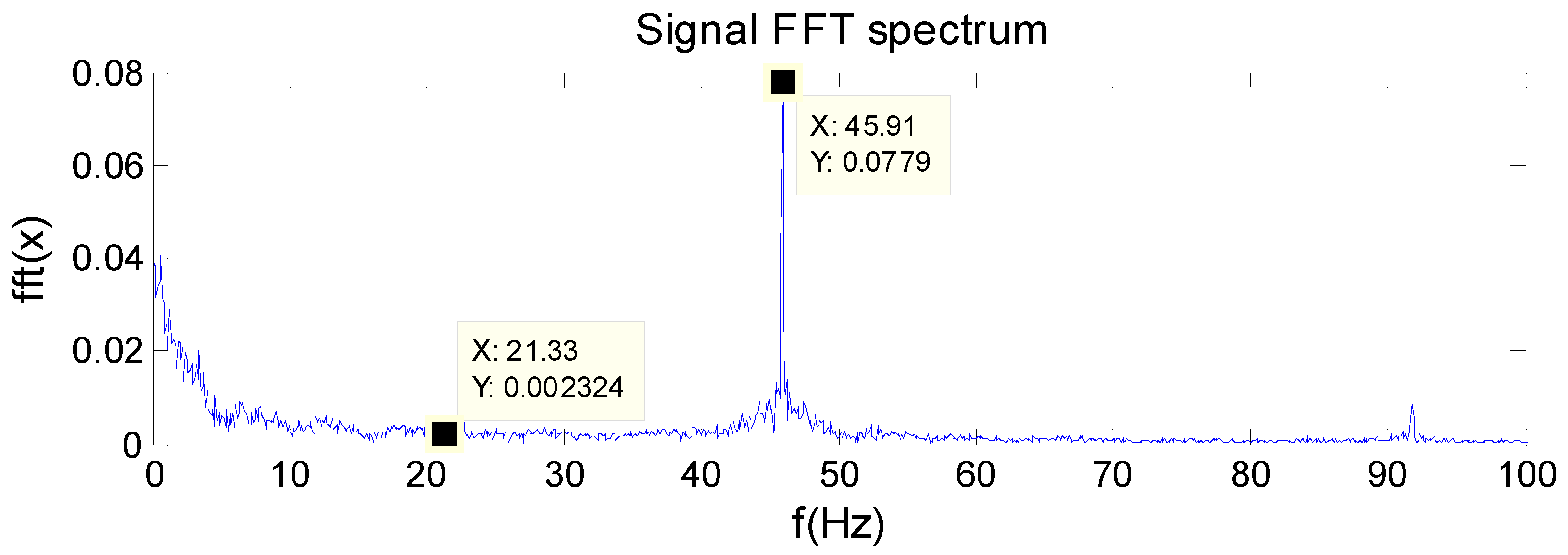



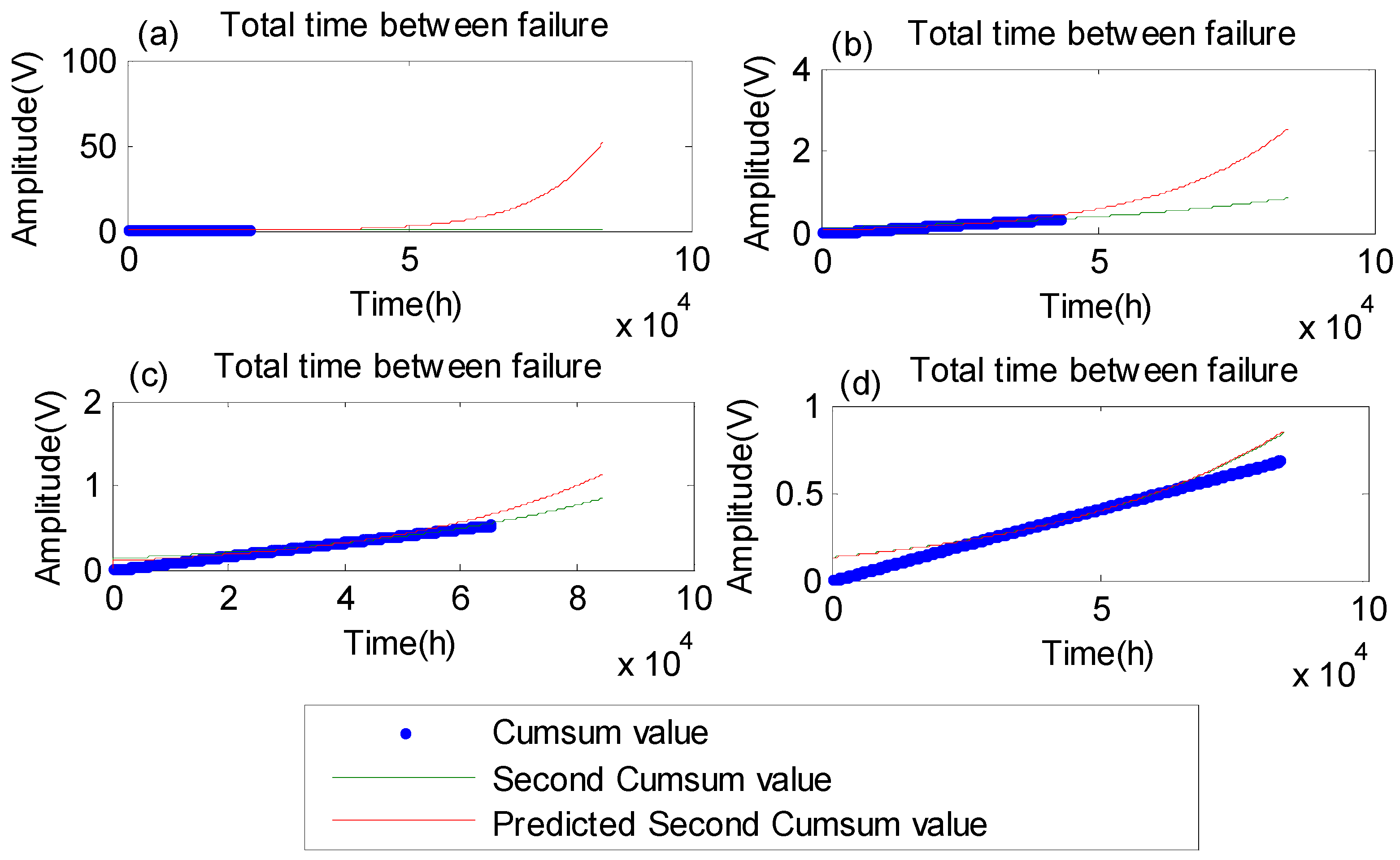
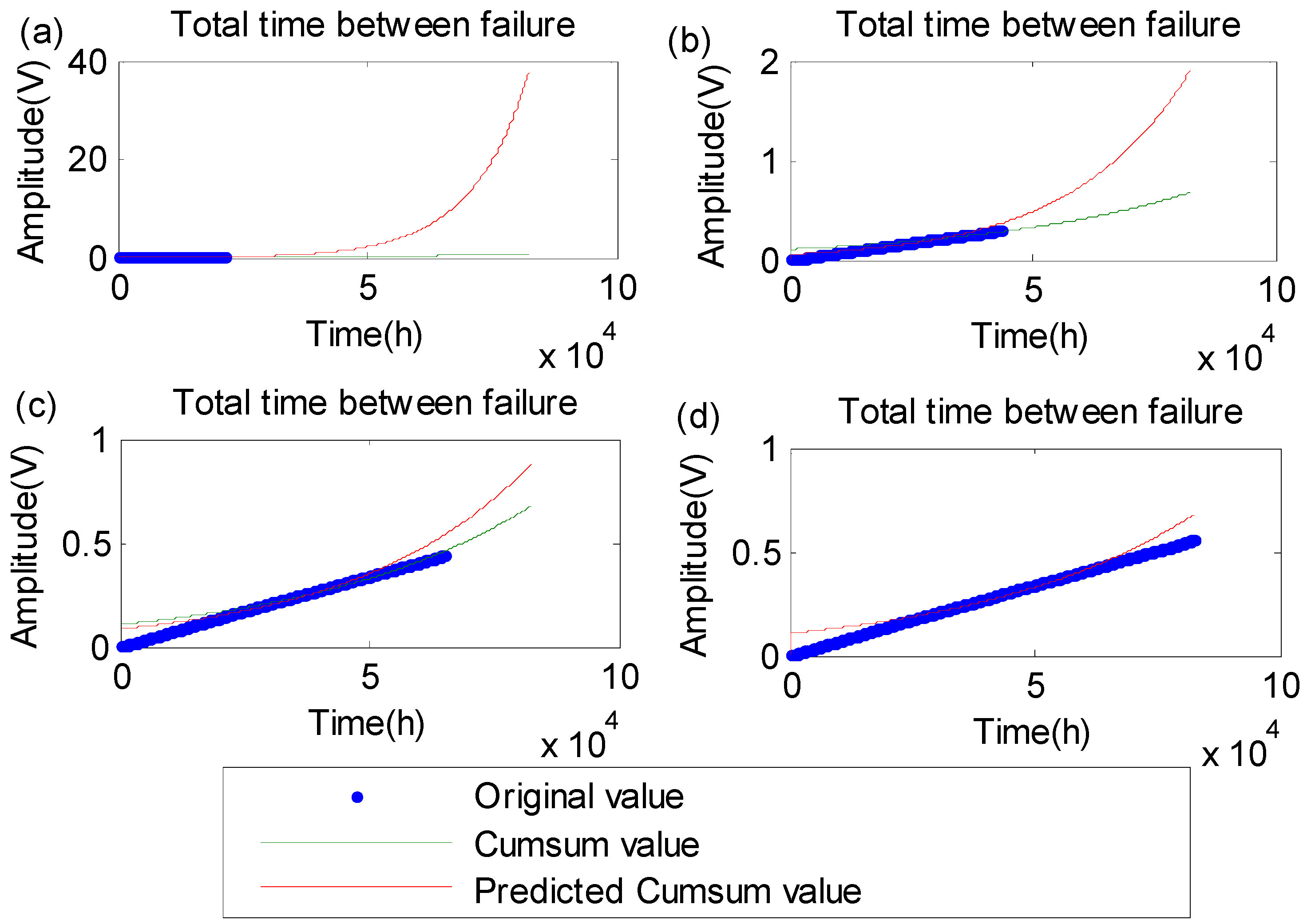

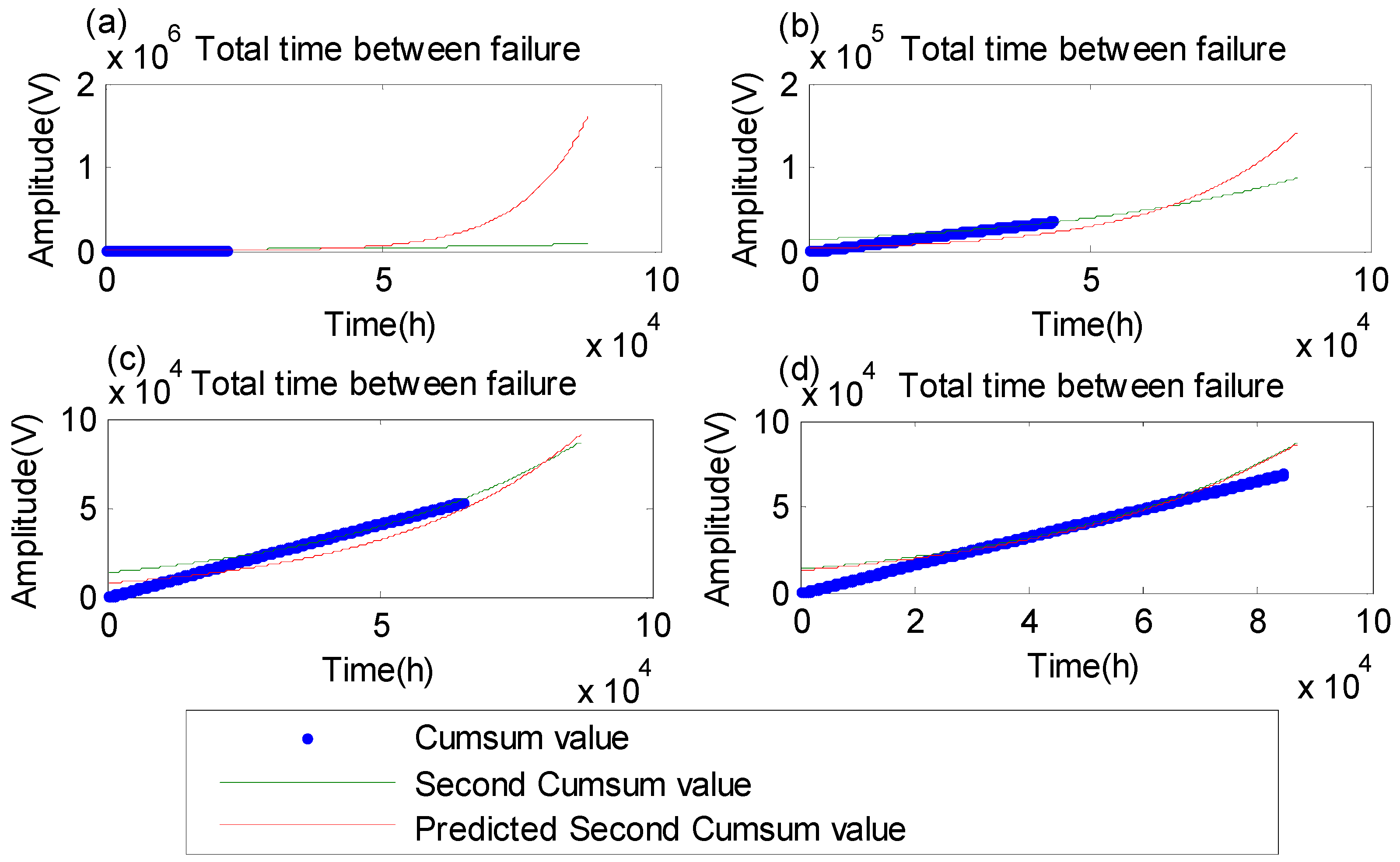

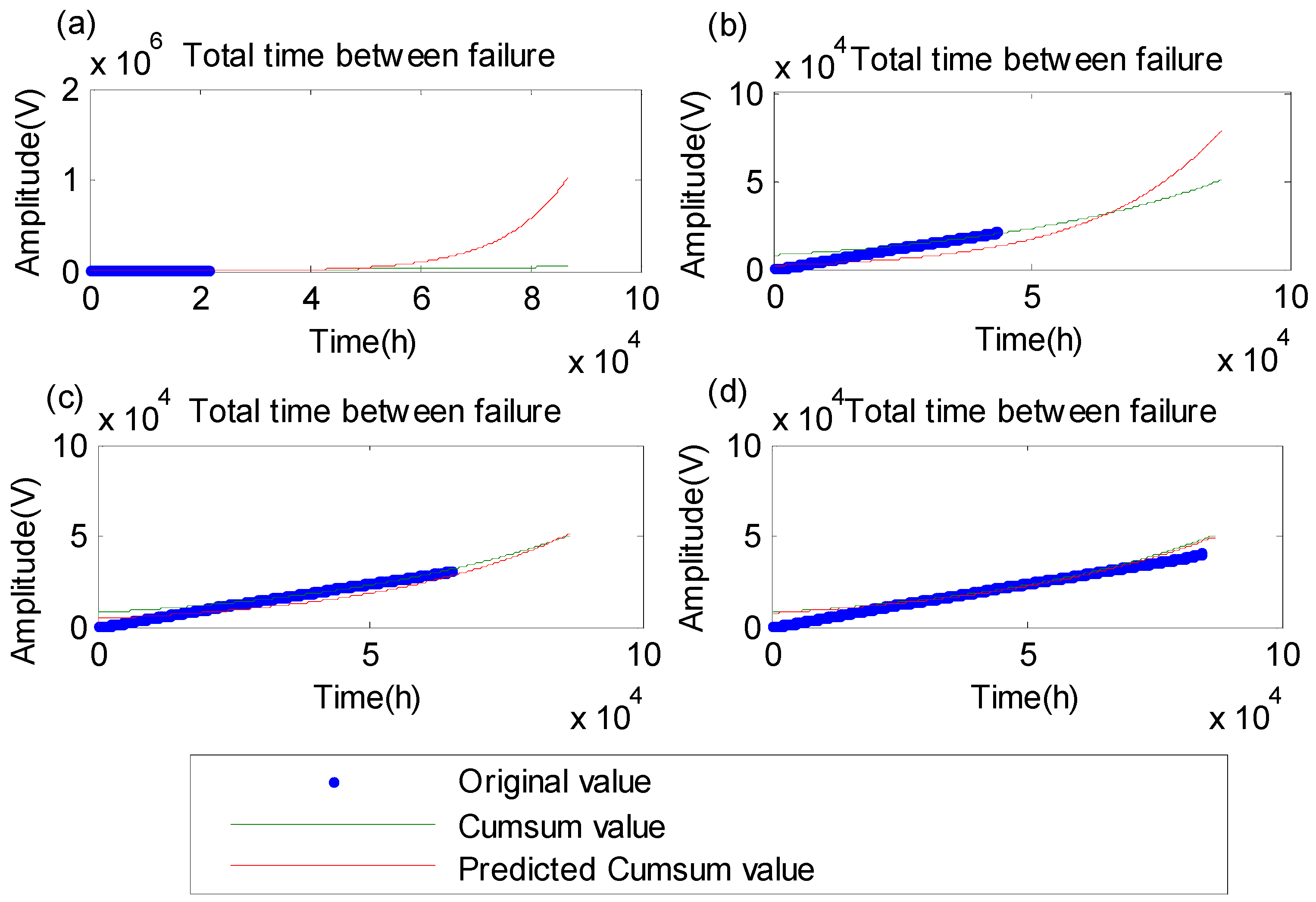
| Accuracy | Original Data (25%) | Original Data (50%) | Original Data (75%) | Original Data (100%) |
|---|---|---|---|---|
| GM | 0.6429 | 0.5571 | 0.5642 | 0.6214 |
| GA | 0.4405 | 0.6905 | 0.8810 | 0.9988 |
| GG | 0.6113 | 0.8708 | 0.9804 | 0.9997 |
| Accuracy | Original Data (25%) | Original Data (50%) | Original Data (75%) | Original Data (100%) |
|---|---|---|---|---|
| GM | 0.6648 | 0.5215 | 0.5279 | 0.6759 |
| GA | 0.4357 | 0.7040 | 0.8910 | 0.9998 |
| GG | 0.6160 | 0.8788 | 0.9880 | 0.9993 |
| Accuracy | Original Data (25%) | Original Data (50%) | Original Data (75%) | Original Data (100%) |
|---|---|---|---|---|
| GM | 0.5026 | 0.3511 | 0.6586 | 0.7264 |
| GA | 0.4280 | 0.6924 | 0.8762 | 0.9909 |
| GG | 0.6050 | 0.8817 | 0.9976 | 0.9996 |
© 2019 by the authors. Licensee MDPI, Basel, Switzerland. This article is an open access article distributed under the terms and conditions of the Creative Commons Attribution (CC BY) license (http://creativecommons.org/licenses/by/4.0/).
Share and Cite
Tang, S.; Gu, J.; Tang, K.; Zou, R.; Sun, X.; Uddin, S. A Fault-Signal-Based Generalizing Remaining Useful Life Prognostics Method for Wheel Hub Bearings. Appl. Sci. 2019, 9, 1080. https://doi.org/10.3390/app9061080
Tang S, Gu J, Tang K, Zou R, Sun X, Uddin S. A Fault-Signal-Based Generalizing Remaining Useful Life Prognostics Method for Wheel Hub Bearings. Applied Sciences. 2019; 9(6):1080. https://doi.org/10.3390/app9061080
Chicago/Turabian StyleTang, Shixi, Jinan Gu, Keming Tang, Rong Zou, Xiaohong Sun, and Saad Uddin. 2019. "A Fault-Signal-Based Generalizing Remaining Useful Life Prognostics Method for Wheel Hub Bearings" Applied Sciences 9, no. 6: 1080. https://doi.org/10.3390/app9061080





